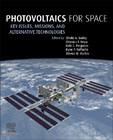
Photovoltaics for Space: Key Issues, Missions and Alternative Technologies
Bailey, Sheila
Hepp, Aloysius F.
Ferguson, Dale
Raffaelle, Ryne P.
Durbin, Steven
PV has traditionally been used for electric power in space. Solar panels on spacecraft are usually the sole source of power to run the sensors, active heating and cooling, and communications. Photovoltaics for Space: Key Issues, Missions and Alternative Technologies provides an overview of the challenges to efficiently produce solar power in near-Earth space and beyond: the materials and device architectures that have been developed to surmount these environmental and mission-specific barriers. The book is organized in four sections consisting of detailed introductory and background content as well as a collection of in-depth space environment, materials processing, technology, and mission overviews by international experts. This book will detail how to design and optimize a space power system's performance for power-to-weight ratio, effectiveness at end of operational life (EOL) compared to beginning of operational life (BOL), and specific mission objectives and goals. This book outlines the knowledge required for practitioners and advanced students interested in learning about the background, materials, devices, environmental challenges, missions, and future for photovoltaics for space exploration. Provides an update to state-of-the-art and emerging solar cell technologies Features comprehensive coverage of solar cells for space exploration and materials/device technology options available Explains the extreme conditions and mission challenges to overcome when using photovoltaics in space INDICE: A. Introduction and Background 1. Historical Introduction to Space Photovoltaics 2. Summary of Key Environmental Issues and Considerations 3. Calibration of Solar Cells in AM0 4. Thermal Issues 5. Analysis for Non-Radiative Recombination Loss and Radiation Degradation of Si Space Solar Cells B. Materials Systems and Processing 6. Recent Advances in High Efficiency Si Solar Cells for Space Power 7. High-Efficiency III-V Multi-junction Cells for Space Power 8. Hydride Vapor Phase Epitaxy for Aerospace Applications 9. Organic and Perovskite Solar Cells for Space Applications 10. Advanced Materials Processing and Systems for Space Power 11. Epitaxial Lifted-Off Thin Film GaInP/GaAs/GaInNAsSb Lattice-Matched Triple Junction Solar Cells C. Systems for Near Earth and Related Applications 12. Photovoltaic and Related Technologies to Enable Space Solar Power 13. Nanowire Solar Cells: Radiation Hard PV Technology for Space 14. Investigation of Radiative Coupling from InGaAsP Quantum Wells for Improving End-of-Life (EOL) Efficiency in Multijunction Solar Cells 15. Low-Cost PV Systems for Communications Constellations D. Deep-Space Missions and Beyond 16. Potential of High Stability Perovskite Solar Cells for Low-Intensity-Low-Temperature (LILT) Outer Planetary Space Missions 17. Space PV Concentrators for Outer Planet and Near-Sun Missions Using Ultra-Light Fresnel Lenses 18. Deep-Space Solar Array Power Prediction Using Monte Carlo Simulation with Low-Intensity/Room-Temperature and Low-Intensity/Low-Temperature Solar Cell Ground Test Data 19. COMPASS Analysis of Power Systems 20. Future Materials and Device Developments for Space Photovoltaics
- ISBN: 978-0-12-823300-9
- Editorial: Elsevier
- Encuadernacion: Rústica
- Páginas: 500
- Fecha Publicación: 01/09/2022
- Nº Volúmenes: 1
- Idioma: Inglés
